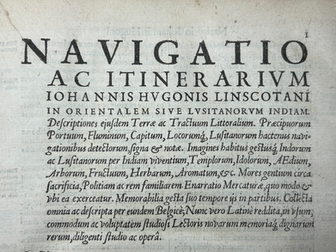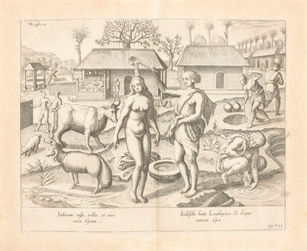
ITINERARIUM, Jan Huyghen van Linschoten, Latin edition 1599
Jan Huyghen van Linschoten Navigatio ac Itinerarium ... in Orientalem sive Lusitanorum Indiam
First Latin edition of 1599
Type of object:
Atlases, Book & Prints
Time period:
Gouden eeuw Nederland
Place:
Hagae-Comitis
Date:
1599
Maker / Author:
Jan Huyghen van Linschoten
Publisher / Printer:
Hagae-Comitis, Albrecht Hendrickz, for the author and Cornelius Nicolaius / Aeg. Elsevier
Dimensions:
310 x 200 mm
Material:
Copper prints, maps, contempary vellum binding
Graduation:
n/a
Inscription:
none on vellum, some annotaions in text
Provenance:
The Hague
References:
n/a

Description
2 parts in 1 vol. in-folio (310 x 200 mm), viii, 124, 45, [3] pp. Title to each part with large ship-vignette, full-page engraved illustration of dedicatee's arms, full-page engraved PORTRAIT of the author with four small inset maps at corners, 7 folding engraved maps:
1. WORLD MAP by Arnold and Hendrik van Langren after Jan Baptist Vrients ;
2. East Coast of Africa;
3. Coast around Indian Ocean;
4. Coasts of China, Sumatra & Java ;
5. West Coast of Africa ;
6. ARCTIC OCEAN;
7. Central & South American Coasts,
+ 31 plates (costumes and botanical subjects), 5 folding plates (City of Goa, Market of Goa, two of Sancta Helena, City of Angra). The plates are signed by Baptista van Doetecum and Jan van Doetecum the younger, others by Arnold Florensz. van Langren, and Hendrik Florensz. van Langren, after Willem Barents, A.F. van Langren and Linschoten. The first edition was in Dutch
This is the first Latin edition of 1599 and the first with the map of the arctic region and Nova Zembla in a fourth book . All figures and maps have explanations in Latin and Dutch.
The English edition appeared in London with all new maps and titels in 1598 ( Discours of Voyages into Ye East & West Indies)
This work was held in such high esteem that for nearly a century a copy was given to voyagers to the East Indies for use as a pilot guide. This no doubt accounts for the fact that fine copies, with all maps and plates present, are so rare.
As well as including important travel accounts taken from contemporary Portuguese, Dutch, and Spanish sources, it is the first work to include precise sailing instructions for the Indies, and also includes an account of America as well as secrets about Portuguese sea routes to the east and about how their territories were governed; it was also of special value for its description of spice trees and spice growing areas.
About the world map: This double-hemisphere map is notable for several reasons. As Shirley notes, ""there are differences affecting the northern seas, and the pictorial scenes forming the outer border have been regrouped with even greater stylistic effect."" It is also the second-known map to depict Korea as a peninsula. Finally, the watermark, that of crossed arrows 90mm in length, is different to the other watermarks found on the other van Langren and van Doetecum maps and plates in the book (bunch of grapes terminating in initials I.S.)
The name Plancius is removed from this second edition, because of the protestant fame of Plancius, to be able to sell this latin book also elsewhere.
About the author: Linschoten, a Dutchman born in Delft, was in Goa between 1583 and 1589, and with Willem Barentsz on his second voyage to the Kara Sea in 1594-1595. These experiences were recorded in the present work, which was first published in Dutch (without our Naova Zembla map), and contains the most comprehensive account of the East and West Indies available at the end of the 16th century.
Additional information






























